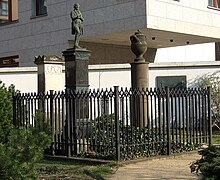Johann Gottfried Schadow
[2][3] After he married Devidel in Rome he also won the sculptors prize from the Accademia di San Luca in 1786.Upon his return, his first work was the tomb of the son of the Prussian King Friedrich Wilhelm II, Alexander von der Mark.[1] The second one was copied many times illegally which lead to a temporary dispute between his gypsum modeler Beyer and the sculptor in September 1795.[1] His busts, of which there are more than one hundred, include seventeen colossal heads in the Walhalla, Ratisbon; Goethe, Wieland, and Fichte were modelled from life.He is claimed by classicists and idealists: the quadriga on the Brandenburger Tor and the allegorical frieze on the facade of the Royal Mint, both in Berlin, are judged among the happiest studies from the antique.

PrussiansculptorBrandenburg GateBerlinAntoine TassaertFrederick the GreatAccademia di San LucaAntonio CanovaPrussian Academy of ArtsRoral Porcelain FactoryFriedrich Wilhelm IIStettinBlücherRostockLutherWittenbergPrincess Monument Louise and her sister FredericaWalhallaGoetheWielandFichtequadrigaBrandenburger TorHarry MaiteyFriedrichswerdersche KircheAlte NationalgalerieBritish MuseumRudolphFriedrich WilhelmFelix von BendemannGerman Imperial NavyFrederica of PrussiaPrinzessinengruppeFriedericaLouiseEmil Wolffpublic domainChisholm, HughEncyclopædia BritannicaEncyclopedia Americana